Efficient Schemes for Optimizing Load Balancing and Communication Cost in Edge Computing Networks †
Abstract
1. Introduction
- A comprehensive survey of existing physical edge server placement solutions to determine edge server deployments.
- The formal formulations of a communication cost minimization subproblem, a load balancing optimization subproblem and a bi-objective optimization problem that aims to jointly optimize load balancing and mean latency scores in the network.
- The formal description of a novel service node selection scheme that attempts to evenly distribute service nodes across the edge network.
- The formal description of a novel access nodes allocation scheme that attempts to allocate access nodes to the most appropriate service node by simultaneously incorporating proximity-based and load balance decision criteria.
- The ability of the algorithms to tackle both uniform and non-uniform (random) load distribution.
- The adaptation of other previously proposed heuristics to include load balance in their decisions and their formal descriptions.
- The time complexity analysis of all schemes presented.
- Our proposed algorithms not only produce near optimum load balance and effective communication cost solutions, but also exhibit great scalability and significantly lower execution times compared to the other proposed heuristics.
2. Related Work
3. System Model and Problem Statement
4. Proposed Policies
4.1. Edge Service Node Selection Scheme
| Algorithm 1 Edge Service Node Selection |
| Input: Network topology of M ANs, ANs’ computational load , and number N of SNs. Output: Set S of N ANs to operate as edge SNs.
|
4.2. Load Balanced and Node Proximity Access Node Allocation to SNs Scheme
| Algorithm 2 Load Balanced and Node Proximity Access Node Allocation |
| Input: Network topology of M ANs and set S of N ANs to operate as edge SNs. Output: Set with the ANs, assigned to SN , .
|
4.3. Previously Proposed Approaches with Load Balance Enhancement
4.3.1. Load Balanced Forward Greedy
4.3.2. Load Balanced Reverse Greedy
| Algorithm 3 Forward Greedy with Load Balance |
| Input: Network topology of M ANs, ANs’ computational load , and number N of SNs. Output: Set of N ANs to operate as edge SNs and sets with the ANs, assigned to SN .
|
| Algorithm 4 Reverse Greedy with Load Balance |
| Input: Network topology of M ANs, ANs’ computational load , and number N of SNs. Output: Set of N ANs to operate as edge SNs and sets with the ANs, assigned to SN .
|
4.3.3. Load Balanced Local Search
| Algorithm 5 Local Search with Load Balance |
| Input: Network topology of M ANs, ANs’ computational load , and set of N ANs as the initial starting set of SNs. Output: Set of N ANs to operate as edge SNs and sets with the ANs, assigned to SN .
|
5. Evaluation Results and Discussion
5.1. Experimental Environment
5.2. Communication Cost of Node Proximity Schemes vs. Node Proximity with Load Balance Schemes
5.3. Load Balancing of Node Proximity with Load Balance Schemes
5.4. Bi-Objective Function Results of Node Proximity with Load Balance Schemes
5.5. Computational Times
6. Conclusions
Author Contributions
Funding
Data Availability Statement
Conflicts of Interest
Abbreviations
| 5G | 5th Generation |
| AN | Access Node |
| ANA | Access Node Allocation |
| AR | Augmented Reality |
| BTS | Base Transceiver Station |
| CAPABLE | Cost Aware cloudlet PlAcement in moBiLe Edge computing |
| CAPEX | Capital Expenditures |
| ELBS | Energy-aware Load Balancing and Scheduling |
| FG | Forward Greedy |
| FGLB | Forward Greedy with Load Balance |
| IoT | Internet of Things |
| IoV | Internet of Vehicles |
| IT | Information Technology |
| LAB | LoAd Balancing |
| LS | Local Search |
| LSLB | Local Search with Load Balance |
| MEC | Mobile Edge Computing |
| MHP2P | Mobile Hybrid hierarchical Peer-to-Peer |
| OPEX | Operating Expenditures |
| QoE | Quality of Experience |
| QoS | Quality of Service |
| RG | Reverse Greedy |
| RGLB | Reverse Greedy with Load Balance |
| SN | Service Node |
| SNLB | edge Service Node selection with Load Balance and node proximity AN allocation |
| SNNP | edge Service Node selection with Node Proximity AN allocation |
| SNS | Service Node Selection |
| WMAN | Wireless Metropolitan Area Network |
References
- Satyanarayanan, M. The Emergence of Edge Computing. Computer 2017, 50, 30–39. [Google Scholar] [CrossRef]
- Wu, Q.; Wang, W.; Fan, P.; Fan, Q.; Wang, J.; Letaief, K.B. URLLC-Aware Resource Allocation for Heterogeneous Vehicular Edge Computing. IEEE Trans. Veh. Technol. 2024, 73, 11789–11805. [Google Scholar] [CrossRef]
- Satyanarayanan, M.; Bahl, P.; Caceres, R.; Davies, N. The Case for VM-Based Cloudlets in Mobile Computing. IEEE Pervasive Comput. 2009, 8, 14–23. [Google Scholar] [CrossRef]
- Hu, Y.C.; Patel, M.; Sabella, D.; Sprecher, N.; Young, V. Mobile edge computing: A key technology towards 5G. ETSI White Paper 2015, 11, 1–16. [Google Scholar]
- Reznik, A.; Arora, R.; Cannon, M.; Cominardi, L.; Featherstone, W.; Frazao, R.; Giust, F.; Kekki, S.; Li, A.; Sabella, D.; et al. Developing Software for Multi-Access Edge Computing. ETSI White Paper 2017, 20, 1–16. [Google Scholar]
- Bonomi, F.; Milito, R.A.; Natarajan, P.; Zhu, J. Fog computing: A platform for Internet of Things and analytics. In Big Data and Internet of Things: A Roadmap for Smart Environments; Springer: Cham, Switzerland, 2014; pp. 169–186. [Google Scholar]
- Bonomi, F.; Milito, R.; Zhu, J.; Addepalli, S. Fog computing and its role in the Internet of Things. In Proceedings of the ACM SIGCOMM Workshop on Mobile Cloud Computing, Helsinki, Finland, 13–17 August 2012; pp. 13–16. [Google Scholar]
- Yousefpour, A.; Fung, C.; Nguyen, T.; Kadiyala, K.; Jalali, F.; Niakanlahiji, A.; Kong, J.; Jue, J.P. All one needs to know about fog computing and related edge computing paradigms: A complete survey. J. Syst. Archit. 2019, 98, 289–330. [Google Scholar] [CrossRef]
- Cao, K.; Liu, Y.; Meng, G.; Sun, Q. An Overview on Edge Computing Research. IEEE Access 2020, 8, 85714–85728. [Google Scholar] [CrossRef]
- Ahmed, A.; Ahmed, E. A survey on mobile edge computing. In Proceedings of the 2016 10th International Conference on Intelligent Systems and Control (ISCO), Coimbatore, India, 7–8 January 2016; pp. 1–8. [Google Scholar]
- Klas, G.I. Fog Computing and Mobile Edge Cloud Gain Momentum Open Fog Consortium, ETSI MEC and Cloudlets. 2015. Available online: https://yucianga.info/wp-content/uploads/2015/11/15_11_22-_Fog_computing_and_mobile_edge_cloud_gain_momentum_Open_Fog_Consortium-ETSI_MEC-Cloudlets_v1_1.pdf (accessed on 19 August 2020).
- Haibeh, L.A.; Yagoub, M.C.E.; Jarray, A. A Survey on Mobile Edge Computing Infrastructure: Design, Resource Management, and Optimization Approaches. IEEE Access 2022, 10, 27591–27610. [Google Scholar] [CrossRef]
- Liu, F.; Tang, G.; Li, Y.; Cai, Z.; Zhang, X.; Zhou, T. A Survey on Edge Computing Systems and Tools. Proc. IEEE 2019, 107, 1537–1562. [Google Scholar] [CrossRef]
- Yu, W.; Liang, F.; He, X.; Hatcher, W.G.; Lu, C.; Lin, J.; Yang, X. A Survey on the Edge Computing for the Internet of Things. IEEE Access 2018, 6, 6900–6919. [Google Scholar] [CrossRef]
- Abbas, N.; Zhang, Y.; Taherkordi, A.; Skeie, T. Mobile edge computing: A survey. IEEE Internet Things J. 2018, 5, 450–465. [Google Scholar] [CrossRef]
- Filali, A.; Abouaomar, A.; Cherkaoui, S.; Kobbane, A.; Guizani, M. Multi-Access Edge Computing: A Survey. IEEE Access 2020, 8, 197017–197046. [Google Scholar] [CrossRef]
- Wang, S.; Xu, J.; Zhang, N.; Liu, Y. A Survey on Service Migration in Mobile Edge Computing. IEEE Access 2018, 6, 23511–23528. [Google Scholar] [CrossRef]
- Khan, W.Z.; Ahmed, E.; Hakak, S.; Yaqoob, I.; Ahmed, A. Edge computing: A survey. Future Gener. Comput. Syst. 2019, 97, 219–235. [Google Scholar] [CrossRef]
- Kong, L.; Tan, J.; Huang, J.; Chen, G.; Wang, S.; Jin, X.; Zeng, P.; Khan, M.; Das, S.K. Edge-computing-driven Internet of Things: A Survey. ACM Comput. Surv. 2022, 55, 174. [Google Scholar] [CrossRef]
- Mao, Y.; You, C.; Zhang, J.; Huang, K.; Letaief, K.B. A survey on mobile edge computing: The communication perspective. IEEE Commun. Surv. Tutor. 2017, 19, 2322–2358. [Google Scholar] [CrossRef]
- Jia, M.; Cao, J.; Liang, W. Optimal cloudlet placement and user to cloudlet allocation in wireless metropolitan area networks. IEEE Trans. Cloud Comput. 2017, 5, 725–737. [Google Scholar] [CrossRef]
- Wang, S.; Zhao, Y.; Xu, J.; Yuan, J.; Hsu, C.-H. Edge server placement in mobile edge computing. J. Parallel Distrib. Comput. 2019, 127, 160–168. [Google Scholar] [CrossRef]
- Guo, Y.; Wang, S.; Zhou, A.; Xu, J.; Yuan, J.; Hsu, C.-H. User allocation-aware edge cloud placement in mobile edge computing. Softw. Pract. Exp. 2020, 50, 489–502. [Google Scholar] [CrossRef]
- Kasi, S.K.; Kasi, M.K.; Ali, K.; Raza, M.; Afzal, H.; Lasebae, A.; Naeem, B.; Islam, S.; Rodrigues, J.J. Heuristic edge server placement in industrial internet of things and cellular networks. IEEE Internet Things J. 2021, 8, 10308–10317. [Google Scholar] [CrossRef]
- Asghari, A.; Sohrabi, M.K. Multiobjective Edge Server Placement in Mobile-Edge Computing Using a Combination of Multiagent Deep Q-Network and Coral Reefs Optimization. IEEE Internet Things J. 2022, 9, 17503–17512. [Google Scholar] [CrossRef]
- Jia, M.; Liang, W.; Xu, Z.; Huang, M.; Ma, Y. QoS-Aware Cloudlet Load Balancing in Wireless Metropolitan Area Networks. IEEE Trans. Cloud Comput. 2020, 8, 623–634. [Google Scholar] [CrossRef]
- Jia, M.; Liang, W.; Xu, Z.; Huang, M. Cloudlet load balancing in wireless metropolitan area networks. In Proceedings of the IEEE INFOCOM 2016, San Francisco, CA, USA, 10–14 April 2016. [Google Scholar]
- Wan, J.; Chen, B.; Wang, S.; Xia, M.; Li, D.; Liu, C. Fog Computing for Energy-Aware Load Balancing and Scheduling in Smart Factory. IEEE Trans. Ind. Inform. 2018, 14, 4548–4556. [Google Scholar] [CrossRef]
- Meng, J.; Shi, W.; Tan, H.; Li, X. Cloudlet Placement and Minimum-Delay Routing in Cloudlet Computing. In Proceedings of the 2017 3rd International Conference on Big Data Computing and Communications (BIGCOM), Chengdu, China, 10–11 August 2017; pp. 297–304. [Google Scholar]
- Xu, Z.; Liang, W.; Xu, W.; Jia, M.; Guo, S. Efficient algorithms for capacitated cloudlet placements. IEEE Trans. Parallel Distrib. Syst. 2016, 27, 2866–2880. [Google Scholar] [CrossRef]
- Li, Y.; Wang, S. An Energy-Aware Edge Server Placement Algorithm in Mobile Edge Computing. In Proceedings of the 2018 IEEE International Conference on Edge Computing (EDGE), San Francisco, CA, USA, 2–7 July 2018; pp. 66–73. [Google Scholar]
- Ceselli, A.; Premoli, M.; Secci, S. Mobile Edge Cloud Network Design Optimization. IEEE/ACM Trans. Netw. 2017, 25, 1818–1831. [Google Scholar] [CrossRef]
- Fan, Q.; Ansari, N. On cost aware cloudlet placement for mobile edge computing. IEEE/CAA J. Autom. Sin. 2019, 6, 926–937. [Google Scholar] [CrossRef]
- Sun, X.; Ansari, N. Green cloudlet network: A sustainable platform for mobile cloud computing. IEEE Trans. Cloud Comput. 2018, 8, 180–192. [Google Scholar] [CrossRef]
- Lähderanta, T.; Leppänen, T.; Ruha, L.; Lovén, L.; Harjula, E.; Ylianttila, M.; Riekki, J.; Sillanpää, M.J. Edge computing server placement with capacitated location allocation. J. Parallel Distrib. Comput. 2021, 153, 130–149. [Google Scholar] [CrossRef]
- Fan, Q.; Ansari, N. Towards workload balancing in fog computing empowered IoT. IEEE Trans. Netw. Sci. Eng. 2020, 7, 253–262. [Google Scholar] [CrossRef]
- Duan, Z.; Tian, C.; Zhang, N.; Zhou, M.; Yu, B.; Wang, X.; Wu, Y. A novel load balancing scheme for mobile edge computing. J. Syst. Softw. 2022, 186, 111195. [Google Scholar] [CrossRef]
- Liu, H.; Wang, S.; Huang, H.; Ye, Q. On the Placement of Edge Servers in Mobile Edge Computing. In Proceedings of the 2023 International Conference on Computing, Networking and Communications (ICNC), Honolulu, HI, USA, 20–22 February 2023; pp. 496–500. [Google Scholar]
- Oikonomou, E.; Rouskas, A. Selection of Service Nodes in Edge Computing Environments. In Proceedings of the 2020 7th International Conference on Internet of Things: Systems, Management and Security (IOTSMS), Paris, France, 14–16 December 2020; pp. 1–6. [Google Scholar]
- Oikonomou, E.; Rouskas, A. Optimizing load balancing and minimizing communication latency in edge networks. In Proceedings of the 2024 IEEE 22nd Mediterranean Electrotechnical Conference (MELECON), Porto, Portugal, 25–27 June 2024; pp. 820–825. [Google Scholar]
- Li, S. On Uniform Capacitated k-Median Beyond the Natural LP Relaxation. ACM Trans. Algorithms 2017, 13, 1–18. [Google Scholar] [CrossRef]
- Boyd, S.; Vandenberghe, L. Convex Optimization; Cambridge University Press: Cambridge, UK, 2004. [Google Scholar]
- Han, J.; Kamber, M.; Pei, J. Data Mining: Concepts and Techniques. In The Morgan Kaufmann Series in Data Management Systems; Morgan Kaufmann: Burlington, MA, USA, 2012. [Google Scholar]
- Charikar, M.; Guha, S.; Tardos, É.; Shmoys, D.B. A constant-factor approximation algorithm for the k-median problem. J. Comput. Syst. Sci. 2002, 65, 129–149. [Google Scholar] [CrossRef]
- Chrobak, M.; Kenyon, C.; Young, N. The reverse greedy algorithm for the metric k-median problem. Inf. Process. Lett. 2006, 97, 68–72. [Google Scholar] [CrossRef][Green Version]
- Arya, V.; Garg, N.; Khandekar, R.; Munagala, K.; Pandit, V. Local search heuristic for k-median and facility location problems. In Proceedings of the 33rd ACM Symposium on Theory of Computing, Hersonissos, Greece, 6–8 July 2001; pp. 21–29. [Google Scholar]
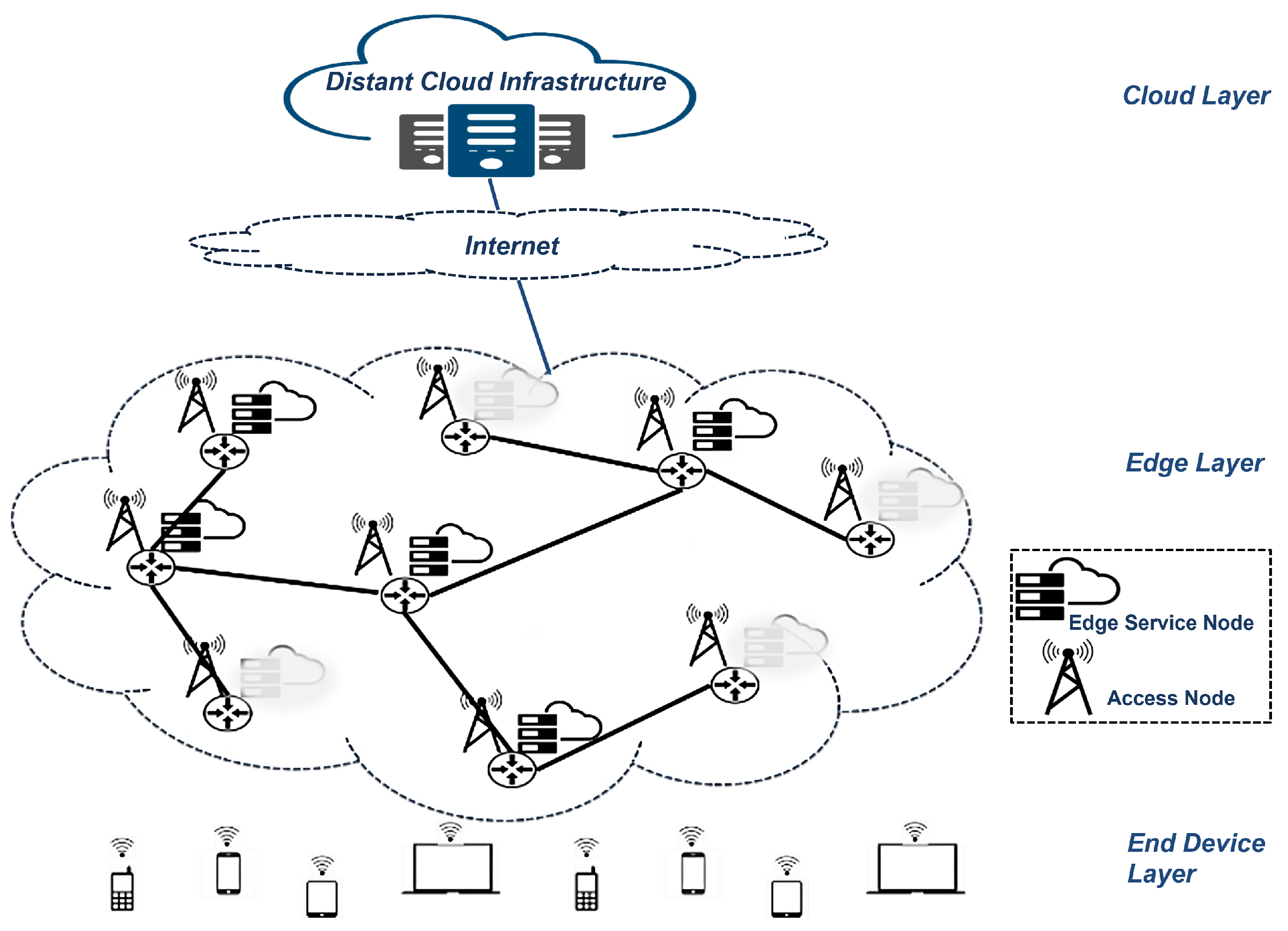
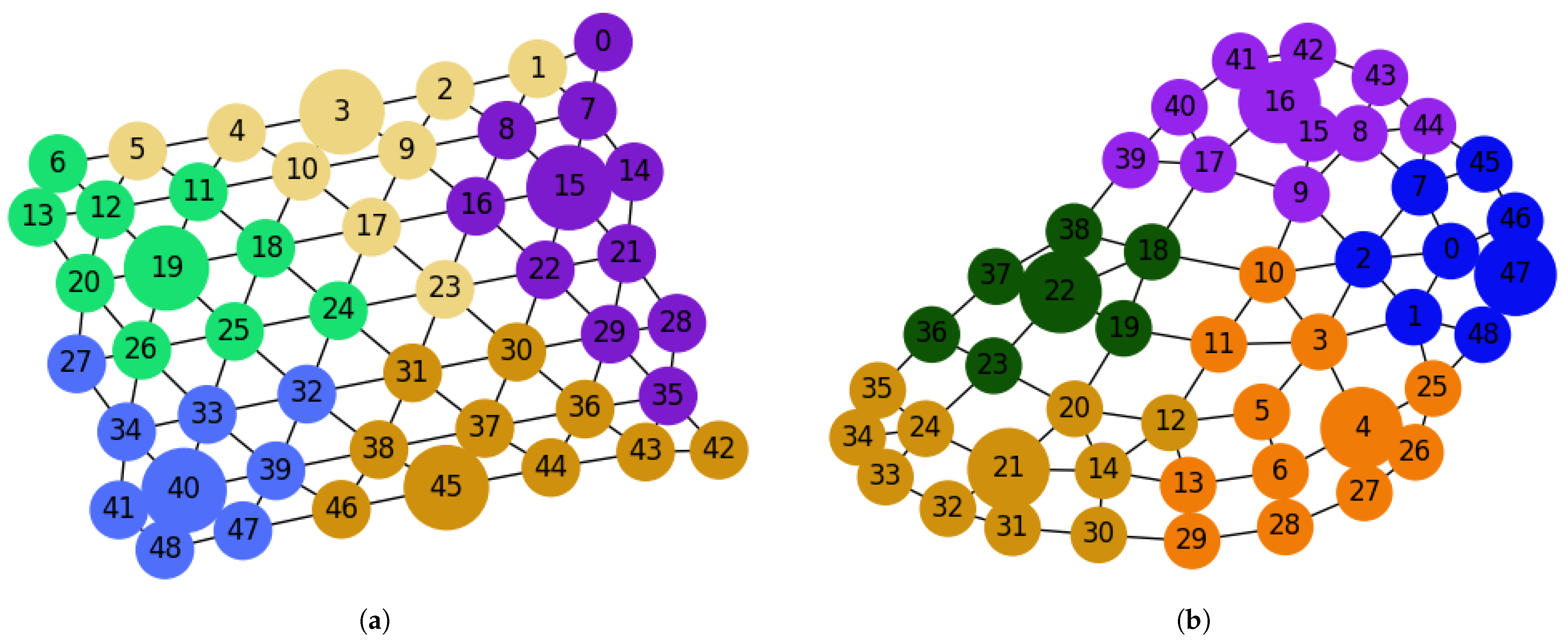
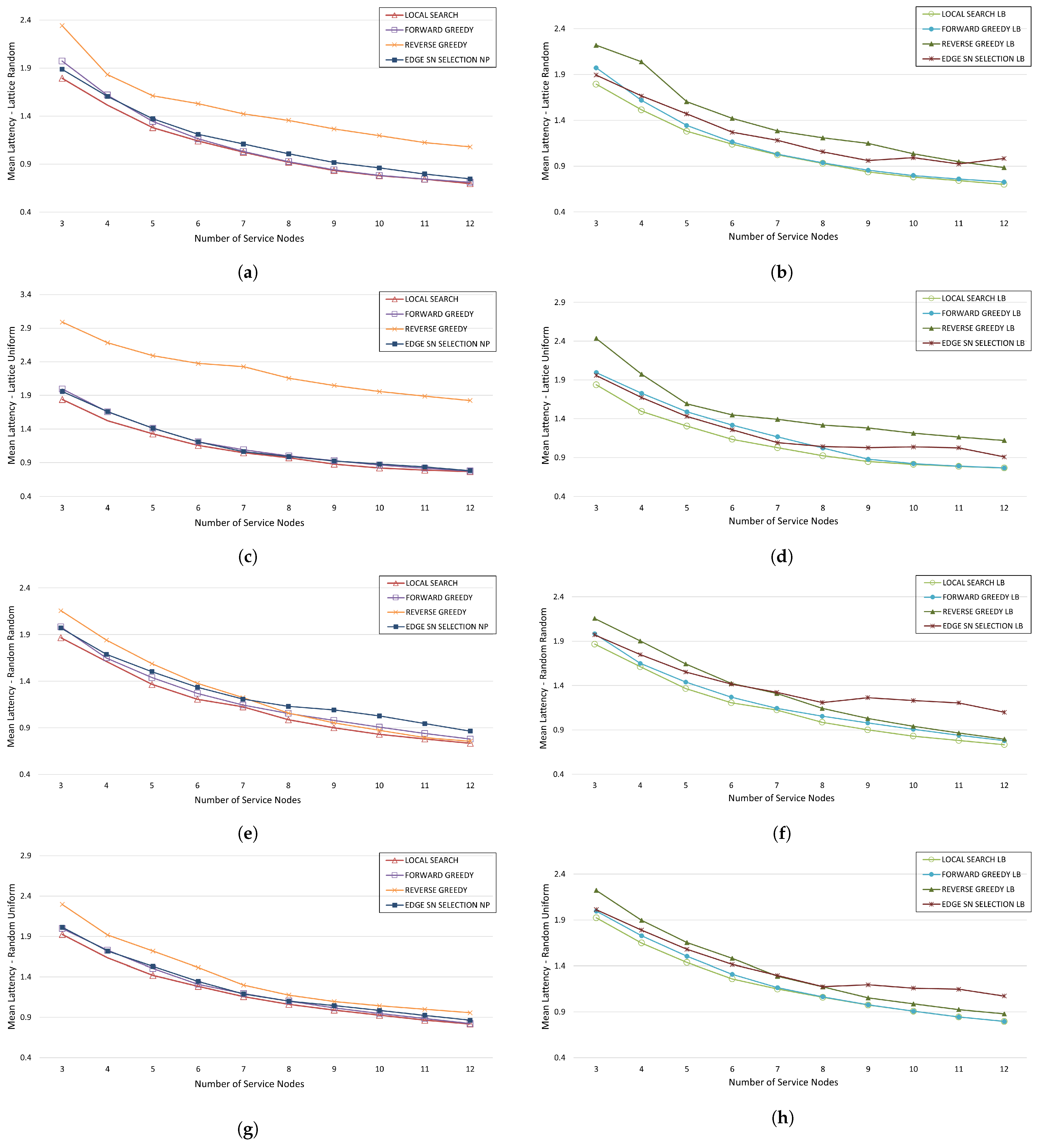
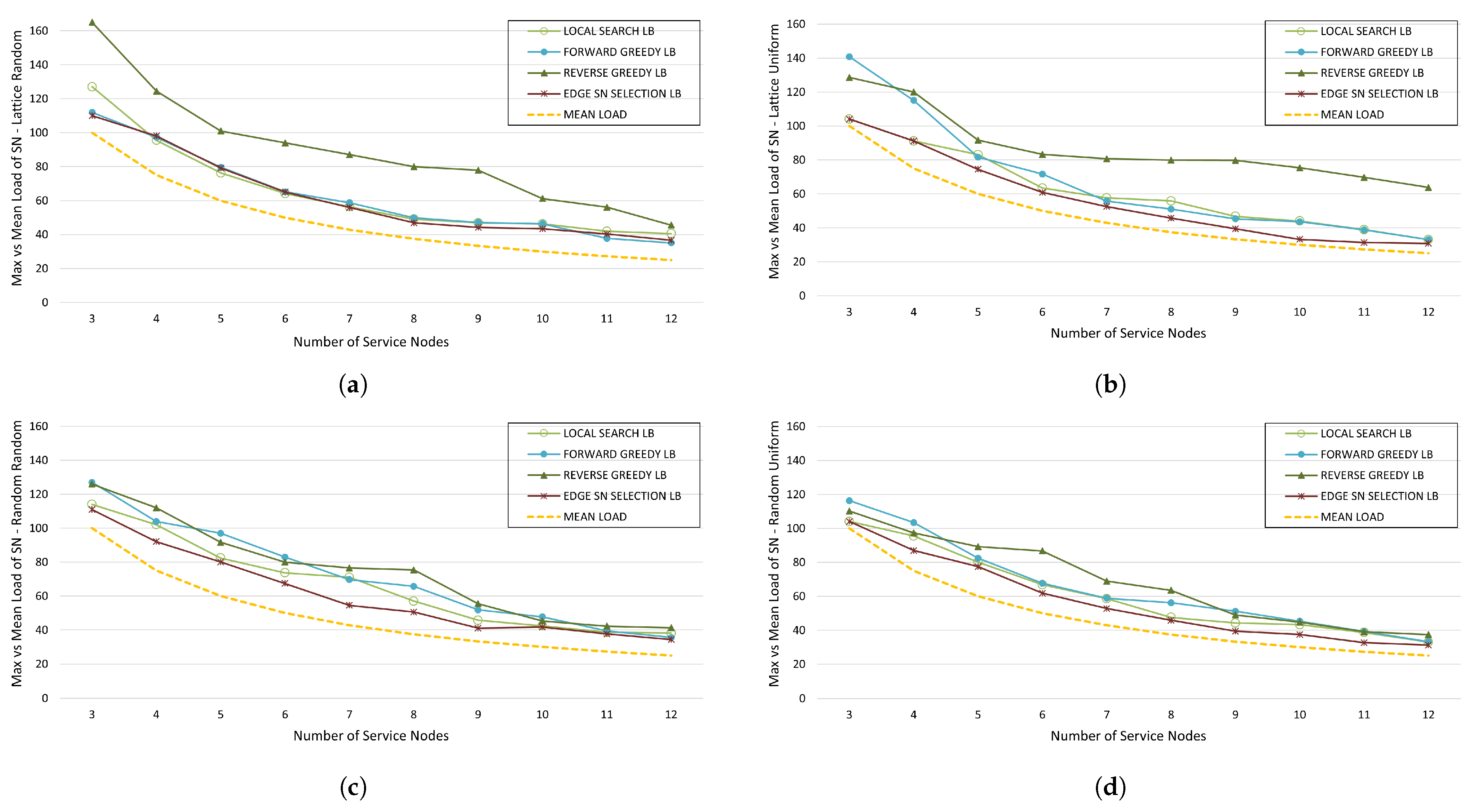
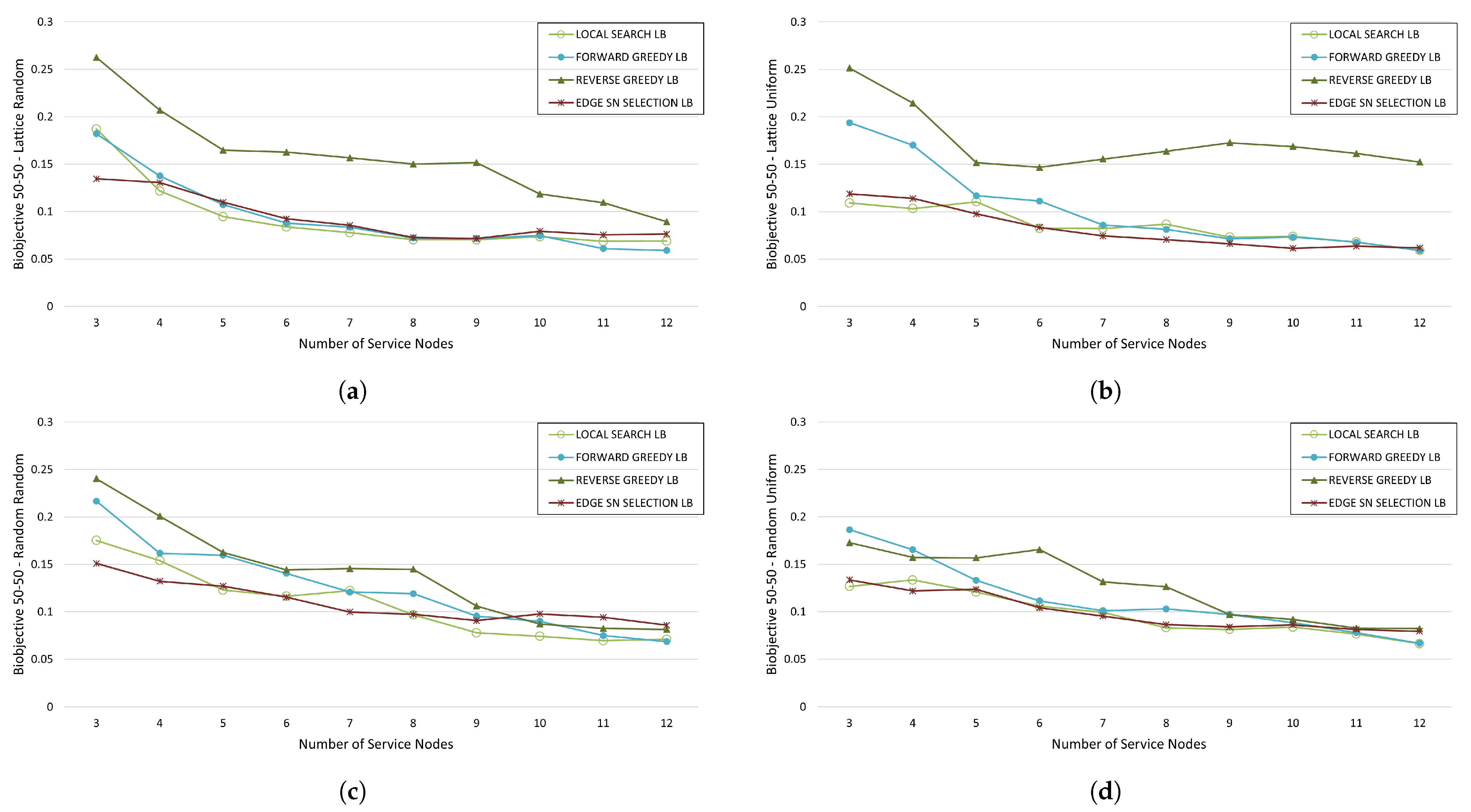
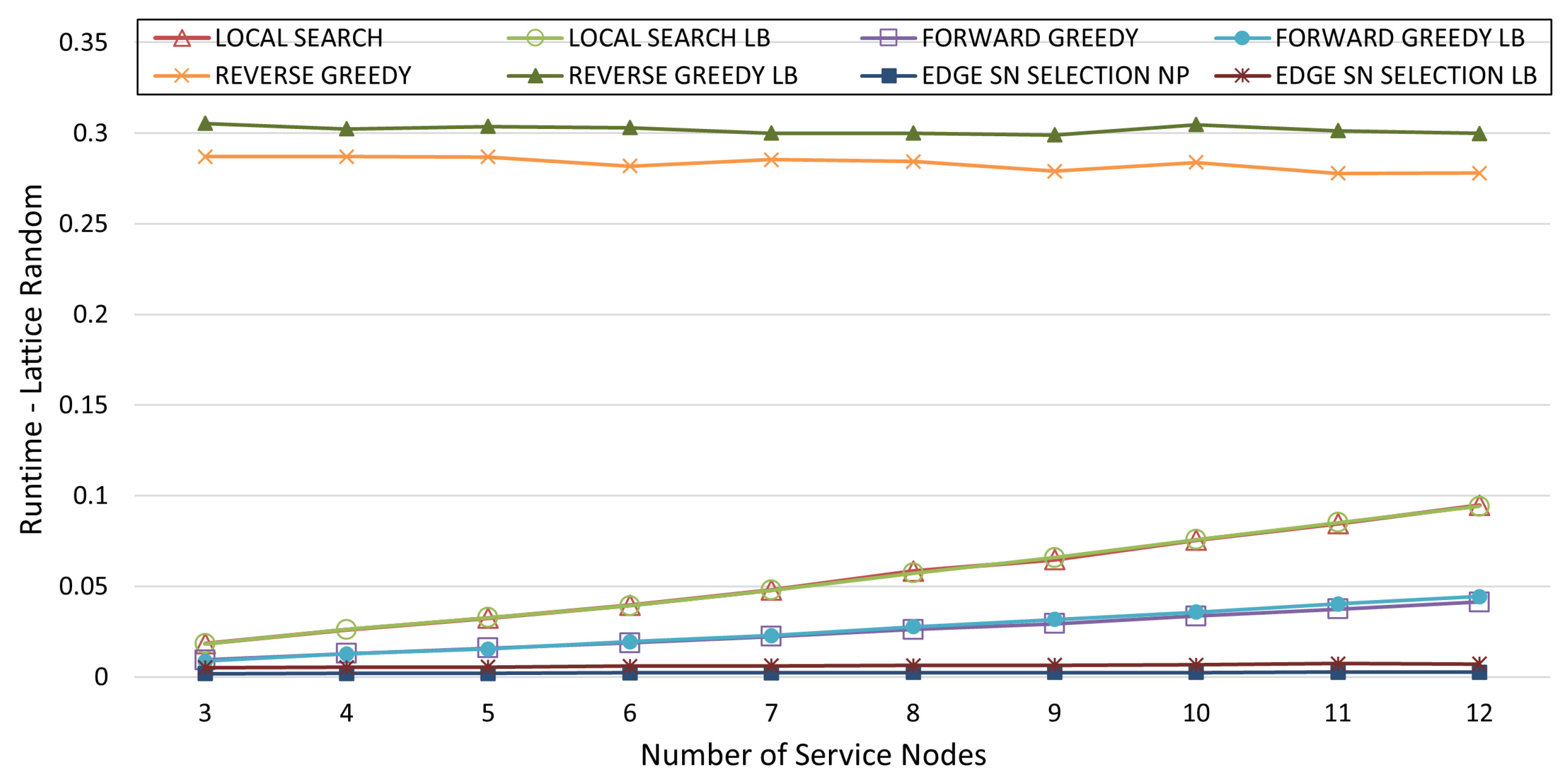
| Scheme | Abbreviation | ANs to SNs Allocation Criterion | |
|---|---|---|---|
| Node Proximity | Load Balance | ||
| Edge Service Node Selection (Algorithm 1) with Node Proximity AN Allocation | SNNP | ✓ | |
| Edge Service Node Selection (Algorithm 1) with Load Balance and Node Proximity AN Allocation (Algorithm 2) | SNLB | ✓ | ✓ |
| Forward Greedy (Algorithm 3 without line 5) | FG | ✓ | |
| Forward Greedy with Load Balance (Algorithm 3) | FGLB | ✓ | ✓ |
| Reverse Greedy (Algorithm 4 without line 4) | RG | ✓ | |
| Reverse Greedy with Load Balance (Algorithm 4) | RGLB | ✓ | ✓ |
| Local Search (Algorithm 5 without second OR clause in line 9) | LS | ✓ | |
| Local Search with Load Balance (Algorithm 5) | LSLB | ✓ | ✓ |
Disclaimer/Publisher’s Note: The statements, opinions and data contained in all publications are solely those of the individual author(s) and contributor(s) and not of MDPI and/or the editor(s). MDPI and/or the editor(s) disclaim responsibility for any injury to people or property resulting from any ideas, methods, instructions or products referred to in the content. |
© 2024 by the authors. Licensee MDPI, Basel, Switzerland. This article is an open access article distributed under the terms and conditions of the Creative Commons Attribution (CC BY) license (https://creativecommons.org/licenses/by/4.0/).
Share and Cite
Oikonomou, E.; Rouskas, A. Efficient Schemes for Optimizing Load Balancing and Communication Cost in Edge Computing Networks. Information 2024, 15, 670. https://doi.org/10.3390/info15110670
Oikonomou E, Rouskas A. Efficient Schemes for Optimizing Load Balancing and Communication Cost in Edge Computing Networks. Information. 2024; 15(11):670. https://doi.org/10.3390/info15110670
Chicago/Turabian StyleOikonomou, Efthymios, and Angelos Rouskas. 2024. "Efficient Schemes for Optimizing Load Balancing and Communication Cost in Edge Computing Networks" Information 15, no. 11: 670. https://doi.org/10.3390/info15110670
APA StyleOikonomou, E., & Rouskas, A. (2024). Efficient Schemes for Optimizing Load Balancing and Communication Cost in Edge Computing Networks. Information, 15(11), 670. https://doi.org/10.3390/info15110670






